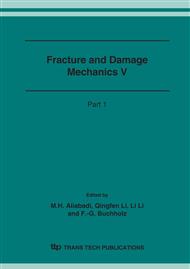p.243
p.247
p.251
p.255
p.259
p.263
p.267
p.271
p.275
Detection of Multiple Cracks in Triangular Cantilevers Based on Frequency Measurements
Abstract:
Triangular cantilevers are used as small force sensors. Prediction of location and size of multiple cracks from experimental results will be of value to users and designers of cantilever deflection force sensors. We extend a method for prediction of location and size of multiple cracks in rectangular cantilevers to deal with triangular cantilevers in this paper. The cracks are assumed to introduce local flexibility change and are modeled as rotational springs. The beam is divided into a number of segments, and each segment is associated with a damage index, which can be calculated through the relationship between the damage index and strain energy of each segment and the changes in the frequencies caused by the cracks. The location of cracks can be obtained with high accuracy with sufficient segment numbers. The size of a crack can be calculated through the relationship between the crack size and its stiffness, which can be obtained from the damage index related to the crack. The maximum error in prediction of the crack position in the case of double cracks is less than 15%, and it is less than 25% in prediction of the crack size.
Info:
Periodical:
Pages:
259-262
Citation:
Online since:
November 2006
Authors:
Price:
Сopyright:
© 2006 Trans Tech Publications Ltd. All Rights Reserved
Share:
Citation:


